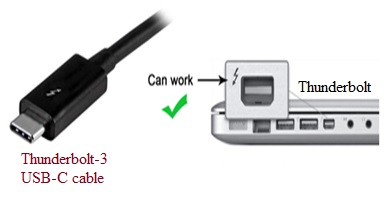
Introduction:
The Thunderbolt technology is transformational high speed, dual core I/O protocol which offers excellent performance over current I/O technologies available in market. It is the fastest data ports available. This interface supersedes Firewire interface.
Due to thunderbolt technology, it has become possible to connect laptops over single cable to high performance storage, display and multimedia devices. It is compatible with existing DisplayPort devices. It uses native PCIe and DisplayPort Protocol software drivers. It supports power over cable for bus powered devices. It supports daisy chaining for up to six devices.

The thunderbolt types are Thunderbolt 1, Thunderbolt 2, Thunderbolt 3 and Thunderbolt 4. Thunderbolt 1 supports 10 Gbps bi-directional per channel and supports two channels. Hence it can send and receive at 10 Gbps simultaneously on each channel. Thunderbolt 2 supports 20 Gbps where as Thunderbolt 3 and 4 support 40 Gbps.
It has been designed to provide experience of universal cable connectivity like Thunderbolt 3. It supports data, video and power over single cable connection with speeds of 40 Gbps. Thunderbolt 4 is backward compatible with previous versions of Thunderbolt 3, 2, 1 and USB versions. Intel is working towards delivering host controller and device controller for computer and accessory manufacturers respectively at the end of the year 2020. It is the successor to Thunderbolt 3 version.

Thunderbolt 4 supports following requirements.
• One universal computer port
• Universal 40 Gb/s cables up to 2 meters in length.
• Supports two number of 4K displays instead of one (or supports one 8K display)
• Accessories with four Thunderbolt ports
• Required PC charging on at least one computer port
• Required PC wake from sleep when computer is connected to a Thunderbolt dock
• Thunderbolt networking (10 Gbps ethernet connection between PCs)
• Mandatory certification for all shipping computers, accessories and cables
• Cable testing and cable quality audits for Thunderbolt cable manufacturers
• Required Intel VT-d based DMA protection
This Thunderbolt version uses USB-C format and hence ordinary USB-C cables can be used by Thunderbolt 3. It brings Thunderbolt to USB-C at the speed of 40 Gbps. On single cable, it offers four times data, twice video bandwidth compare to other cables and supplies more power. Thunderbolt 3 offers best USB-C with more speed and more pixels.

It supports following features.
• Bi-directional, dual protocol (i.e. PCI Express and DisplayPort)
• 4 lanes PCI Express Gen 3
• 8 Lanes DisplayPort 1.2
• Supports two numbers of 4K displays
• Power (Based on USB delivery) : up to 100 W system charging, 15 W to bus powered devices
Thunderbolt 3 supports following requirements.
• One universal computer port
• Thunderbolt networking
• Mandatory certification for all shipping computers, accessories and cables
• Cable testing and cable quality audits for Thunderbolt cable manufacturers
Following table compares Thunderbolt 4 vs 3 and mentions similarities and difference between Thunderbolt 4 and Thunderbolt 3 types.
| Features | Thunderbolt 4 | Thunderbolt 3 |
|---|---|---|
| Minimum PC Speed requirements | 40 Gbps | 40 Gbps |
| Minimum PC video requirements | Two 4K displays | One 4K display |
| Minimum PC data requirements | PCIe - 32 Gb/s, USB 3.2 - 10 Gbps | PCIe - 16 Gb/s, USB 3.2 - 10 Gbps |
| Minimum PC port power for accessories | 15 W | 15 W |
| USB4 specification | Compliant | Compliant |
Conclusion: From the comparison between Thunderbolt 4 vs 3, we can conclude that Thunderbolt 4 supports the same speed as Thunderbolt 3 i.e. 40 Gbps. Though Thunderbolt 4 supports the same speed it has many better specifications than Thunderbolt 3 as mentioned above.
